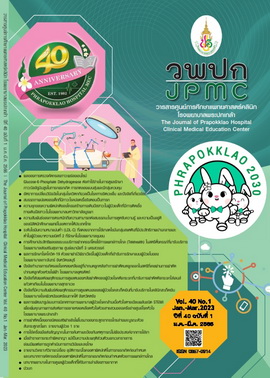Pulmonary Function of Survivors with Bronchopulmonary Dysplasia in Lampang Regional Hospital, Long Term Follow Up
Main Article Content
Abstract
BACKGROUND: Bronchopulmonary dysplasia (BPD) is recognized as a major cause of significant pulmonary sequelae in infants with very low birth weight (VLBW), which may extend into adulthood. Previous studies have demonstrated the relationship between low lung function and future chronic obstructive pulmonary disease (COPD) risk. However, no study has been carried out concerning pulmonary function in VLBW BPD patients in Thailand.
OBJECTIVES: To demonstrate pulmonary function and determine possible modifiers in perinatal and postnatal periods that can worsen or ameliorate the pulmonary function outcomes of BPD in VLBW infants.
METHODS: A retrospective chart review was performed using the birth weight ≤1,500 gm and gestational age < 37 weeks of patients who were admitted to the NICU at Lampang Hospital and received follow-up regularly at the outpatient BPD clinic between October 1, 2006 and September 30, 2020. The demographics, clinical data and pulmonary function study results of 66 VLBW BPD patients were analyzed by Chi-square, t- test, linear regression analysis and Multivariate regression analysis.
RESULTS: A total of 55 patients (83%) performed adequate pulmonary function testing (PFT) according to American Thoracic Society and European Respiratory Society standards. The study population was 58% female and had a mean gestational age of 29.5±2.3 weeks with a mean birthweight of 1,111±219 grams. Spirometry was achieved at an average age of 9.1±2.2 years. The majority of patients with BPD (70.9%) performed normally on the pulmonary function test, while 12.7% of the patients exhibited the presence of restrictions as well as obstruction patterns, and only 3.7% had both. The pulmonary function parameters of the 55 patients were compared with a normal population using the Global lung Initiative (GLI) z-score. The mean forced expiratory volume in 1 s (FEV1) GLI z-score -1.40, forced vital capacity (FVC) GLI z-score -0.82, FEV1/FVC ratio GLI z-score -1.13, forced expiratory flow at 25-75% (FEF 25-75%) GLI z-score -1.79 with lower value associated with oxygen requirement of initial hospital discharge (-0.47±0.12, p<0.001).
Conclusion: The majority of BPD patients in the study had normal pulmonary function results. Patients with severe BPD who required oxygen at the time of hospital discharge were associated with lower pulmonary function parameters.
Article Details

This work is licensed under a Creative Commons Attribution-NonCommercial-NoDerivatives 4.0 International License.
References
Allen J, Zwerdling R, Ehrenkranz R, Gaultier C, Geggel R, Greenough A, et al. Statement on the care of the child with chronic lung disease of infancy and childhood. Am J Respir Crit Care Med 2003;168:356-96.
Jobe AH, Bancalari E. Bronchopulmonary dysplasia. Am J Respir Crit Care Med 2001;163: 1723–9.
Ehrenkranz RA, Walsh MC, Vohr BR, Jobe AH, Wright LL, Fanaroff AA, et al. Validation of the National Institutes of Health consensus definition of bronchopulmonary dysplasia. Pediatrics 2005;116:1353–60.
Jensen EA, Dysart K, Gantz MG, McDonald S, Bamat NA, Keszler M, et al. The diagnosis of bronchopulmonary dysplasia in very preterm infants. an evidence-based approach. Am J Respir Crit Care Med 2019;200:751–9.
Higgins RD, Jobe AH, Koso-Thomas M, Bancalari E, Viscardi RM, Hartert TV, et al. Bronchopulmonary dysplasia: executive summary of a workshop. J Pediatr 2018 ;197:300-8.
McGrath-Morrow SA, Collaco JM. Bronchopulmonary dysplasia: what are its links to COPD?. Ther Adv Respir Dis [Internet]. 2019[cited 2020 Dec 20];13:1753466619892492. Available from: https://www.ncbi.nlm.nih.gov/pmc/articles/PMC6904782/pdf/10.1177_1753466619892492.pdf
Graham BL, Steenbruggen I, Miller MR, Barjaktarevic IZ, Cooper BG, Hall GL, et al. Standardization of spirometry 2019 update. an official American Thoracic Society and European Respiratory Society technical statement. Am J Respir Crit Care Med [Internet]. 2019 [cited 2020 Dec 20]; 200(8):e70-e88. Available from: https://www.ncbi.nlm.nih.gov/pmc/articles/PMC6794117/pdf/rccm.201908-1590ST.pdf
Siffel C, Kistler KD, Lewis JFM, Sarda SP. Global incidence of bronchopulmonary dysplasia among extremely preterm infants: a systematic literature review. J Matern Fetal Neonatal Med 2021 ;34:1721–31.
Global Lung Function Initiative. The Global Lung Function Initiative calculators for Spirometry, TLCO and Lung volume [Internet]. 2021 [cited 2022 Aug 4]. Available from: http://gli-calculator.ersnet.org/index.html
Thai Society for Pediatric Endocrinology . New Thai growth chart by TSPE [Internet]. 2022 [cited 2022 Aug 4]. Available from: https://thaipedendo.org/thai-growth-chart-by-tspe/
Kotecha SJ, Watkins WJ, Paranjothy S, Dunstan FD, Henderson AJ, Kotecha S. Effect of late preterm birth on longitudinal lung spirometry in school age children and adolescents. Thorax 2012;67:54-61.
Thunqvist P, Gustafsson PM, Schultz ES, Bellander T, Berggren-Broström E, Norman M, et al. Lung function at 8 and 16 years after moderate-to-late preterm birth: a prospective cohort study. Pediatrics [Internet]. 2016 [cited 2020 Dec 20];137:e20152056. Available from: https://doi.org/10.1542/peds.2015-2056
Tepper RS, Morgan WJ, Cota K, Taussig LM. Expiratory flow limitation in infants with bronchopulmonary dysplasia. J Pediatr 1986 ;109:1040–6.
Aoyama BC, Collaco JM, McGrath-Morrow SA. Predictors of pulmonary function at 6 years of age in infants with bronchopulmonary dysplasia. Pediatr Pulmonol 2021;56:974-81.
Bui DS, Lodge CJ, Burgess JA, Lowe AJ, Perret J, Bui MQ, et al, Childhood predictors of lung function trajectories and future COPD risk: a prospective cohort study from the first to the sixth decade of life. Lancet Respir Med 2018 ;6:535-4.
Di Filippo P, Giannini C, Attanasi M, Dodi G, Scaparrotta A, Petrosino MI, et al. Pulmonary outcomes in children born extremely and very preterm at 11 years of age. Front Pediatr [Internet]. 2021[cited 2022 Mar 10]; 9:635503. Available from: https://www.ncbi.nlm.nih.gov/pmc/articles/PMC8185052/pdf/fped-09-635503.pdf
Joshi S, Powell T, Watkins WJ, Drayton M, Williams EM, Kotecha S. Exercise-induced bronchoconstriction in school-aged children who had chronic lung disease in infancy. J Pediatr 2013;162:813-8.
Pelkonen AS, Hakulinen AL, Hallman M, Turpeinen M. Effect of inhaled budesonide therapy on lung function in schoolchildren born preterm. Respir Med 2001;95:565-70.

